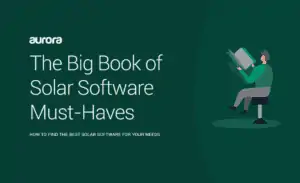When you’re selling solar, there are many boxes that need to be checked before you can even present a proposal to your client. Design, permitting, contracting, financing, it can start to feel overwhelming for your operations — and it can be a real drag on your business and its growth.
There are many tools available to help with these tasks, and choosing one that fulfills your specific needs can help streamline operations.
In this blog post, we’ll look at three critical questions from our new resource, The Big Book of Solar Software Must-Haves. Companies looking to improve their operations and increase their team’s capacity should ask these questions (and more) — and pay close attention to the answers.
Does your software integrate with what I’m already using?
Having to manually enter all your data into several software solutions leads to lots of time wasted. For example, your team may be spending unnecessary time cross-checking data and switching between software programs because your solar software doesn’t sync with other systems. And anything done manually comes with a risk of inaccuracies, which can result in even more time wasted and incorrect contracts and proposals being produced.
One of the best ways to streamline your internal operations is to make sure the solar software you choose lets you easily integrate with any existing tools you already use, such as CRM, contract management software, and so on. So, ask the question, “Does your software integrate with all my tools?” and make sure they provide evidence that it does.
With the ability to sync all your data across your in-house tools, you can better streamline internal operations, avoid human errors, save valuable time, and thereby improve your business.
Does your software cover the entire design to sales process?
As we discussed above, going back and forth between different software solutions can be time consuming and inefficient. When you’ve found your lead, you want to act fast, not waste precious time preparing their proposal.

But, with all the steps necessary to create a permit-ready solar design, many companies turn to several software solutions for different needs. For example, your team might be using one solution to measure your lead’s energy consumption and another to build out the design. The reasons for this can range from pricing, to old habits, or simply because you haven’t yet found a software stack that offers all the things you need in one place.
Every week of delay on a solar project correlates to a 5-10% cancellation rate, according to SEIA and the Solar Foundation. Reducing your time from lead to design, therefore, increases the chances that leads will become customers. This is where a solar software solution that has several tools built-in that can handle all the steps from energy consumption estimates, to design, financing, and sales can really help your business take that next step.
An important question to ask here is, “Does your software cover the entire design to sales process?” Make sure the answer to this question meets your current needs, but think ahead as well. If you invest in software that offers room for growth, you can streamline your current workflows, as well as future ones as your company grows.
What automatic design features does your software have?
The design phase of a solar project can often become a complicated affair and slow down your team’s time to proposal. This is especially true if the software you use doesn’t have components that can automate tasks such as determining the heights of buildings, sizing a system, and predicting weather patterns.

When you’re looking through the different solar software options available, then, ask the vendor specific questions. In this case, you need to know if and how their solution can automatically determine important data that’ll help speed up your team’s workflows.
For example, you might want to ask: “Does the software do automatic system sizing or system stringing?” or “Does it have predictive weather data and irradiance modeling?” That way, you’ll know exactly how the solar software can speed up your workflows, empower your sales team, and even accelerate the onboarding of new employees.
These three questions are a good start when you’re looking for your next solar software. But, there are many other questions and features to consider when you’re optimizing your internal operations to power your company’s growth. To learn more must-ask questions, and must-have features, check out The Big Book of Solar Software Must-Haves.
Different companies have different challenges. Part 1 of this series investigated 3 solar software must-haves for growing small businesses.
